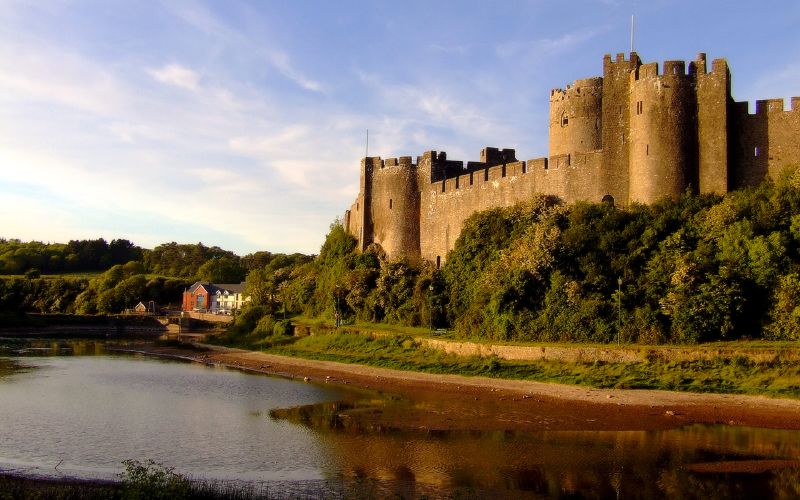|
Emlyn Brown
Emlyn was one of the seven cantrefi of Dyfed, an ancient district of Wales, which became part of Deheubarth in around 950. It consisted of the northern part of Dyfed bordering on the River Teifi. Its southern boundary followed the ridge of the line of hills separating the Teifi valley from the valleys of the Tâf and Tywi. Geography The name derives from ''am'' (around, on both sides of) and ''glyn'' (valley), the valley in question being presumably the Cuch. The Cuch valley is the most prominent valley among the low foothills which lie between the Preseli Hills and Cambrian Mountains, and Emlyn is essentially the region north of, and within, the gap between these landforms. As such, it was the first part of Dyfed to face invaders from Ceredigion. Its area was about . It was divided by the River Cuch into the commotes of Emlyn Is Cuch (to the west) and Emlyn Uwch Cuch to the east. Its civil headquarters were divided between Cilgerran in the lower commote and Newcas ... [...More Info...] [...Related Items...] OR: [Wikipedia] [Google] [Baidu] |
Cenarth
Cenarth () is a village, parish and community in Carmarthenshire, on the border between Ceredigion and Carmarthenshire, and close to the border with Pembrokeshire, Wales. It stands on the banks of the River Teifi, east of Cardigan and west of Newcastle Emlyn, and features the Cenarth Falls, a popular visitor attraction, and several other listed structures including an 18th-century corn mill incorporating the National Coracle Centre. History and governance The ancient parish extended south of the river, and included the town of Newcastle Emlyn. In 1934, it annexed the adjoining parish of East Cilrhedyn, and the enlarged parish corresponds with the modern community, which had a population of 1,022 in the 2001 census. With the community of Newcastle Emlyn, it makes up the Carmarthenshire electoral ward of Cenarth, which had a population of 1,995 in 2001, with 60 per cent Welsh language speakers. The ancient parish (less Newcastle Emlyn) had an area of . Its census populatio ... [...More Info...] [...Related Items...] OR: [Wikipedia] [Google] [Baidu] |
Cilgerran Castle
Cilgerran Castle ( cy, Castell Cilgerran) is a 13th-century ruined castle located in Cilgerran, Pembrokeshire, Wales, near Cardigan. The first castle on the site was thought to have been built by Gerald of Windsor around 1110–1115, and it changed hands several times over the following century between English and Welsh forces. In the hands of William Marshal, 2nd Earl of Pembroke, the construction of the stone castle began after 1223. After passing through successive families, it was left to ruin and eventually abandoned by 1400. The castle backs onto a cliff face, with the remaining ruins dating from the 13th century. It was most heavily fortified where it faces inland, and includes a pair of drum towers, rather than a central keep, which remain standing. It passed into the hands of the National Trust in 1938. It is open to the public on payment of an entry fee but times vary. Description The castle sits on a rocky promontory above the River Teifi, with one side directly ... [...More Info...] [...Related Items...] OR: [Wikipedia] [Google] [Baidu] |
Gerald Of Windsor
Gerald de Windsor (1075 – 1135), ''alias'' Gerald FitzWalter, was an Anglo-Norman lord who was the first Castellan of Pembroke Castle in Pembrokeshire (formerly part of the Kingdom of Deheubarth). Son of the first Constable of Windsor Castle, and married to a Welsh Princess, he was in charge of the Norman forces in south-west Wales. He was also steward and governor for the Norman magnate Arnulf de Montgomery. His descendants were the FitzGerald dynasty, as well as the FitzMaurice, De Barry, and Keating dynasties of Ireland, who were elevated to the Peerage of Ireland in the 14th century. He was also the ancestor of the prominent Carew family, of Moulsford in Berkshire, the owners of Carew Castle in Pembrokeshire (in the Kingdom of Deheubarth) and of Mohuns Ottery in Devon (see Baron Carew, Earl of Totnes and Carew baronets). Origins Father Gerald was probably born at Windsor Castle in Berkshire, then a strategically placed motte-and-bailey royal fortress and a pr ... [...More Info...] [...Related Items...] OR: [Wikipedia] [Google] [Baidu] |


